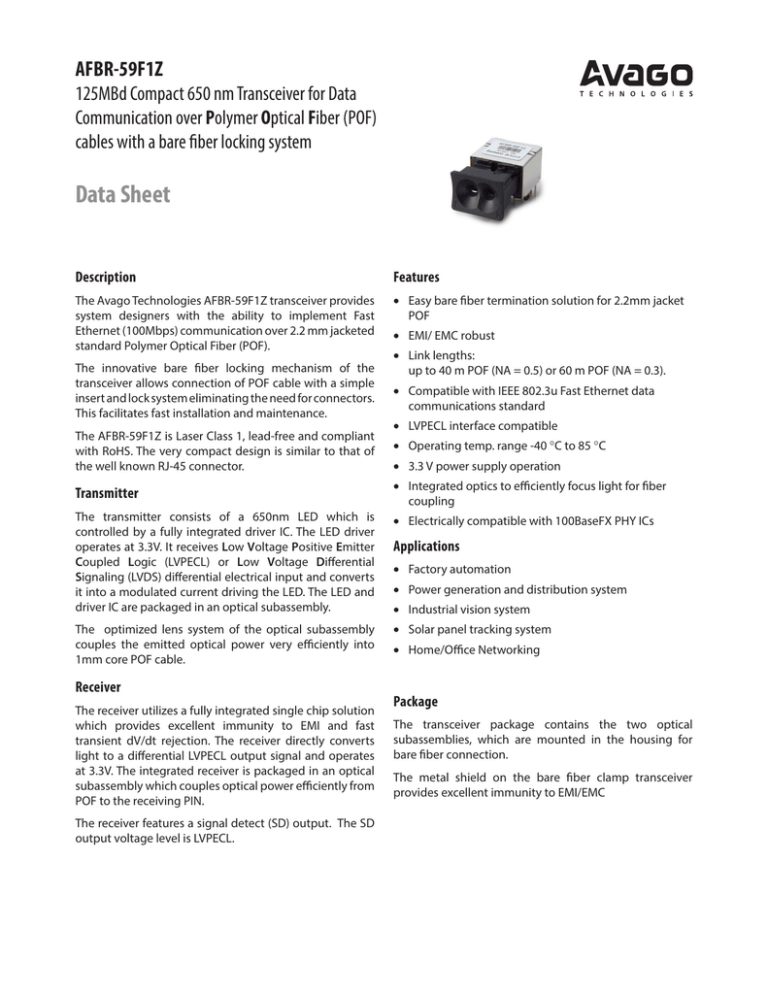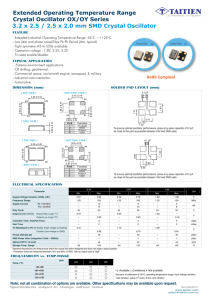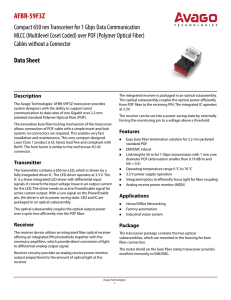
AFBR-59F1Z
125MBd Compact 650 nm Transceiver for Data
Communication over Polymer Optical Fiber (POF)
cables with a bare fiber locking system
Data Sheet
Description
Features
The Avago Technologies AFBR-59F1Z transceiver provides
system designers with the ability to implement Fast
Ethernet (100Mbps) communication over 2.2 mm jacketed
standard Polymer Optical Fiber (POF).
• Easy bare fiber termination solution for 2.2mm jacket
POF
The innovative bare fiber locking mechanism of the
transceiver allows connection of POF cable with a simple
insert and lock system eliminating the need for connectors.
This facilitates fast installation and maintenance.
The AFBR-59F1Z is Laser Class 1, lead-free and compliant
with RoHS. The very compact design is similar to that of
the well known RJ-45 connector.
Transmitter
• EMI/ EMC robust
• Link lengths:
up to 40 m POF (NA = 0.5) or 60 m POF (NA = 0.3).
• Compatible with IEEE 802.3u Fast Ethernet data
communications standard
• LVPECL interface compatible
• Operating temp. range -40 °C to 85 °C
• 3.3 V power supply operation
• Integrated optics to efficiently focus light for fiber
coupling
The transmitter consists of a 650nm LED which is
controlled by a fully integrated driver IC. The LED driver
operates at 3.3V. It receives Low Voltage Positive Emitter
Coupled Logic (LVPECL) or Low Voltage Differential
Signaling (LVDS) differential electrical input and converts
it into a modulated current driving the LED. The LED and
driver IC are packaged in an optical subassembly.
• Electrically compatible with 100BaseFX PHY ICs
The optimized lens system of the optical subassembly
couples the emitted optical power very efficiently into
1mm core POF cable.
• Solar panel tracking system
Receiver
The receiver utilizes a fully integrated single chip solution
which provides excellent immunity to EMI and fast
transient dV/dt rejection. The receiver directly converts
light to a differential LVPECL output signal and operates
at 3.3V. The integrated receiver is packaged in an optical
subassembly which couples optical power efficiently from
POF to the receiving PIN.
The receiver features a signal detect (SD) output. The SD
output voltage level is LVPECL.
Applications
• Factory automation
• Power generation and distribution system
• Industrial vision system
• Home/Office Networking
Package
The transceiver package contains the two optical
subassemblies, which are mounted in the housing for
bare fiber connection.
The metal shield on the bare fiber clamp transceiver
provides excellent immunity to EMI/EMC
Pin description and recommended PCB footprint
AFBR-597F1Z has ten active signal pins (including supply voltage and ground pins), two EMI shield solder posts, two
additional ground pins, and two mounting posts.
The EMI shield solder posts and additional ground pins are isolated from the transceiver internal circuit and should be
connected to the equipment chassis ground or signal ground. Connecting the two additional ground pins to ground
provides EMI shielding to the front of the device. Grounding these pins will also provide a ground connection of the POF
jacket in order to ground small leakage currents in high voltage applications such as in HVDC installations.
The mounting posts provide additional mechanical strength to hold the transceiver module on the application board.
Figure 1 shows the top view of the PCB footprint and pin-out diagram.
Pin Descriptions
Pin No.
Name
Symbol
Pin No. Name
Symbol
1
Data Input (Negative)
TD-
8
Output Signal Detect
SD
2
Data Input (Positive)
TD+
9
Data Output (Negative)
RD-
3
Ground Tx
GND
10
Data Output (Positive)
RD+
4
DC Supply Voltage Tx
Vdd
11
EMI Shield GND
-
5
Ground Tx
GND
12
EMI Shield GND
-
6
DC Supply Voltage Rx
Vdd
13
Additional EMI GND
-
7
Ground Rx
GND
14
Additional EMI GND
-
0
0.76
2.03
3.3
4.57
5.84
Top View
∅0
.8 (
10×
)
7.74
5.2
4.0
1
2
4
3
5
7
6
9
8
.3
∅1
10
12
11
∅1
∅3.2
.3 (2
0
2.74
×)
13
)
(2×
(2×)
Mount Post
Unplated (2×)
14
Outer edge housing
▼
7.83 5.83 3.89
0
Dimension: mm
Recommended PCB thickness: 1.57 ± 0.08
Figure 1. PCB footprint and pin-out diagram: top view
2
FRONT
▼
Recommended Compliance Table
Feature
Test Method
Performance
Electrostatic discharge (ESD)
to the electrical pins
JESD22-A114
Withstands up to 2 kV HBM applied between the electrical pins.
Immunity
Variation of IEC 61000-4-3
Typically shows no measurable effect from a 15 V/m field swept
from 8 MHz to 1 GHz applied to the transceiver when mounted
on a circuit board without chassis enclosure.
Eye safety
EN 60825-1:52007
Laser Class 1 product (LED radiation only). TÜV certificate:
R50217706. Caution – Use of controls or adjustments of
performance or procedures other than those specified
herein may result in hazardous radiation exposure.
Absolute Maximum Ratings
Stresses in excess of the absolute maximum ratings can cause catastrophic damage to the device. Limits apply to each
parameter in isolation; all other parameters having values within the recommended operation conditions. It should not
be assumed that limiting values of more than one parameter can be applied to the products at the same time. Exposure
to the absolute maximum ratings for extended periods can adversely affect device reliability.
Parameter
Symbol
Min.
Max.
Units
Supply Voltage
Vdd Max
-0.5
4.5
V
Storage Temperature
TSTG
-40
85
°C
Lead Soldering Temperature [1]
Tsold
-
260
°C
Lead Soldering Time [1]
tsold
-
10
s
Electrostatic Voltage Capability [2]
ESD
-
2.0
kV
Installation temperature [3]
TI
0
50
°C
Notes:
1. The transceiver is Pb-free wave solderable. According to JEDEC J-STD-020D, the moisture sensitivity classification is MSL2a.
2. ESD capability for all pins HBM (Human Body <odel) according JESD22-A114B
3. Range over which fibers can be connected to or disconnected to/from the bare fiber clamp.
Recommended Operating Conditions
Parameter
Symbol
Min.
Typ.
Max.
Units
Operating temperature
TA
-40
25
85
°C
DC Supply Voltage
Vdd
3.0
3.3
3.6
V
Baud Rate
BR
10
125
MBd
Note
4
Note:
4. Data rate of 100 Mbps with 4b/5b coding.
All the data in this specification refers to the preceding operating conditions and over lifetime, unless otherwise stated.
3
Mechanical Characteristics
Parameter
Min.
Typ.
Max.
Units
Temp. [°C]
Fiber/Cable Retention Force [2]
-
30
-
N
25
10
-
50
N
-40...85 [1]
-
20
-
N
25
30
N
0...50 [1]
-
N
25
20
N
0...50 [1]
Clamp opening force
10
Clamp closing force
-
13
5
Notes:
1. Range over which fibers can be connected/ disconnected to/ from the bare fiber clamp.
2. Measured with Avago's AFBR-HUDxxxZ(2.2mm duplex-fiber, PE-jacket,without connector) with 100mm/ min traction speed.
Transmitter Electrical Characteristics
Parameter
Symbol
Min.
Typ.
Max.
Units
Current Consumption
Idd
-
27
36
mA
Input Capacitance
CIN
-
-
5
pF
Input Resistance (differential)
RIN
-
10
-
kΩ
Input Common-Mode Range
VIN-CM
GND + 0.8
-
VCC – 0.8
V
Input Voltage Swing
VIN-SWING
200
-
2400
mV
Transmitter Optical Characteristics (with standard POF NA = 0.5)
Parameter
Symbol
Min.
Typ.
Max.
Units
Central wavelength
λC
635
650
675
nm
Spectral Bandwidth (RMS) [3]
Δλ
-
-
17
nm
Average Output Power [3, 5]
P
-8.5
-
-2.0
dBm
Optical Rise Time (20% - 80%) [3]
tr
-
1.2
3.0
ns
Optical Fall Time (80% - 20%) [3]
tf
-
1.2
3.0
ns
Extinction Ratio [3]
RE
10
-
-
dB
Data Dependent Jitter [3]
DDJ
-
-
0.6
ns
RJ
-
-
0.76
ns
DCD
-
-
1.0
ns
Random Jitter
[3,4]
Duty cycle distortion [3]
Notes:
3. Measured at the end of 1 m Plastic Optical Fiber (POF) with PRBS 27-1 sequence.
4. Peak-to-peak measurement, based on BER = 2.5 × 10-10
5. Minimum average output power specification value includes 1dB degradation margin.
4
Receiver Electrical Characteristics
Parameter
Symbol
Min.
Typ.
Max.
Units
Current Consumption [1]
Idd
-
41
50
mA
Output Offset Voltage
(VQH+VQnL)/2
-
Vdd – 1.2
-
V
Output Differential Voltage Swing [2, 3]
[VOH-VOL]
600
710
800
mV
Output Rise Time (10% - 90%) [2]
tf
-
1.1
3.0
ns
Output Fall Time (10% - 90%) [2]
tf
-
1.1
3.0
ns
Duty cycle distortion [2]
DCD
-
-
1.0
ns
Data dependent + Random Jitter [2, 4]
DDJ + RJ
-
-
3.3
ns
Notes:
1.AC-coupled
2. Differential output signal is measured with reference transmitter source, 0.5m POF cable, and PRBS 27-1 sequence
3.Single-ended
4. Peak-to-peak measurement, based on BER = 2.5 x 10-10
Receiver Optical Characteristics
Parameter
Symbol
Min.
Typ.
Max.
Units
Central wavelength
λC
635
650
675
nm
Minimum Receiver Input Power [5]
Pin Min
-23
-
-
dBm
Maximum Receiver Input Power [5]
Pin Max
-
-
-2
dBm
Signal Detect Output Voltage – High [5, 6]
VOH – Vdd
-
-0.8
-
V
Signal Detect Output Voltage – Low [5, 6]
VOL – Vdd
-
-1.7
-
V
Signal Detect Asserted [7]
PA
-
-33
-
dBm
Signal Detect De-asserted [7]
PD
-
-35
-
dBm
Signal Detect Hysteresis
PA – PD
-
2.0
-
dB
Notes:
5. Average optical power, measured with a PRBS 27-1 sequence, BER = 2.5 x 10-10
6. Termination as shown in figure 3
7. The Signal Detect function is in an electrical HIGH state under normal signaling operation. If the receive optical power falls below the minimum
threshold for a period of 100 µs, the SD function will toggle to a LOW state.
5
2.54 (6x)
2.54
4.0 ± 0.15
5.2
9.4 ± 0.2
0
2.74
6.65
1.52
7.78
11.65
1.27 (8x)
Mechanical Data - Package Outline
4.9
6
0.25 ± 0.05 (10×)
2.6
3.75 ± 0.2
3
11.4
10.85 ± 0.2
0.9 ± 0.15
0.25 ± 0.05
0.5 ± 0.05 (10×)
15.8 ± 0.2
15
Notes:
1. Dimension: mm
2. General tolerance: ±0.1
3. Recommended PCB thickness: 1.57 ± 0.08
4. Design related is a small gap between plastic
part and dust plug possible. Function is nevertheless given.
24.4 ± 0.25
Clamp open
Clamp with Dust Plug
+0.4 [4]
12 ± 0.2
15.5 ± 0.25
29.2 -0.2
Figure 2. Package Outline Drawing
6
General Application Circuit
The recommended application circuit is shown in figure 3.
AFBR-59F1Z
RD+
RD-
RD-
100 nF
SD
150
150
GND
Vdd
SD
Amplifier +
100 nF
AFBR-2127Z
Quantizer
RD+
GND
10K
100 µF
10 nF
100 nF
Ferrite
GND
Vdd
10 µF
TD+
TD-
100 nF
10 nF
GND
TD+
100
TD-
AFBR-1127Z
LED Driver
GND
3.3 V
100 nF
Chassis GND
Figure 3. General Application Circuit
Board layout- Decoupling circuit and Ground Planes
To achieve optimum performance from the AFBR-59F1Z transceiver module it is important to take note of the following
recommendations; A power supply decoupling circuit should be used to filter out noise and assure optical product
performance; A contiguous signal ground plane should be provided directly beneath transmitter and receiver for low
inductance ground to signal return current; The shield posts should be connected to chassis ground or signal ground to
provide optimum EMI and ESD performance. These recommendations are in keeping with good high frequency board
layout practices. The optimum grounding strategy will depend on customer overall system architecture.
Figure 3 shows the minimum external circuitry between AFBR-59F1Z transceiver module and PHY chip. Please use the
product information of the actual PHY chip for connecting to the AFBR-59F1Z.
7
Figure 4. AFBR-59F1Z with dust plug
Figure 5. AFBR-59F1Z without dust plug
For product information and a complete list of distributors, please go to our web site:
www.avagotech.com
Avago, Avago Technologies, and the A logo are trademarks of Avago Technologies in the United States and other countries.
Data subject to change. Copyright © 2005-2015 Avago Technologies. All rights reserved.
AV02-4107EN - February 16, 2015




